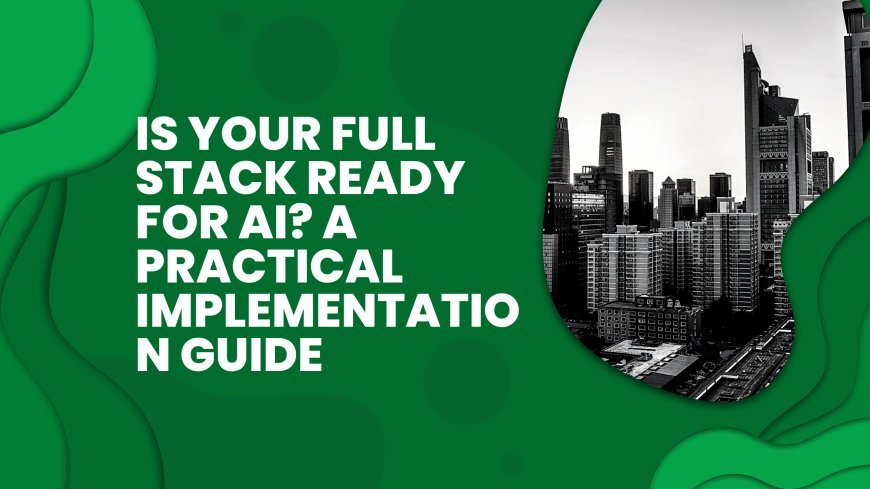Is Your Full Stack Ready for AI? A Practical Implementation Guide

The Age of Full Stack Intelligence Has Arrived
Let's start with the truth: AI is no longer a buzzword. It's not a futuristic concept you keep on the back burner for when you "scale." It’s here. And it’s not politely knocking at your tech stack’s door—it’s kicking it in.
If you're building digital products in 2025 without considering AI, you’re essentially showing up to a Formula One race in a go-kart. The modern full stack is no longer just about versatility and responsiveness—it's about intelligence. And integrating AI isn’t a shiny add-on; it’s a foundational layer that redefines how each tier of your stack should behave, respond, and evolve.
But what does "AI-ready full stack" actually mean? How do you practically begin this transformation without blowing up your architecture or budget? This guide pulls back the curtain on real-world implementation. We’re going in—clear-headed, curious, and a little cynical about hype.
What AI Integration Actually Looks Like in a Full Stack
Let’s cut through the noise. AI isn’t a single tool you install. It’s a layered approach that needs to plug into both the front end and back end of your applications—while quietly influencing your data infrastructure, API logic, and user experience design.
At the front end, AI integration might mean:
-
Predictive search bars
-
Dynamic UI adjustments based on behavior
-
Personalized content recommendations
-
Voice and visual recognition interfaces
At the back end, we’re talking:
-
Machine learning-driven data classification
-
AI-based security anomaly detection
-
Real-time analytics engines that adjust workflows
-
Generative AI for automated content creation or code generation
And somewhere in between? Middleware and APIs that serve as the neural pathways, funneling intelligence across layers without bottlenecks.
Auditing Your Stack: Are You Even Ready?
Before you start piling AI tools onto your app like sprinkles on a sundae, pause. You need a solid technical baseline. Here’s a quick self-audit checklist:
-
Scalability: Can your current back end handle the increased data loads and real-time requests that AI demands?
-
Modularity: Are your components decoupled enough to integrate third-party AI APIs or custom ML models?
-
Data Hygiene: Is your data pipeline clean, reliable, and structured for training models?
-
Latency Readiness: Are you optimized for low-latency communication between layers?
-
Security: Are you ready for the privacy implications that come with handling behaviorally-driven insights?
Be honest here. AI is merciless with bad infrastructure. Trying to force it into a brittle stack is like installing a rocket engine in a shopping cart.
Front-End Evolution: Where AI Meets UX
Design isn’t just visual anymore; it’s predictive. An AI-aware front end anticipates needs. That means no more static pages. Instead, you’re building:
-
Adaptive Interfaces: Reacting to user behavior in real-time
-
Conversational UIs: Integrating natural language processing
-
Vision-Based Inputs: Letting users interact through gestures or images
Frameworks like React and Vue are already AI-compatible through libraries and third-party services. You just need to stitch in the logic. For example, using TensorFlow.js to run lightweight models directly in the browser is no longer experimental. It’s efficient. And increasingly expected.
Back-End Power Plays: The Brain Behind the Interface
Think of the back end as the nervous system that makes the intelligence flow. This is where your real transformation begins.
-
Model Hosting: Are you using services like AWS SageMaker or running PyTorch models in containers?
-
Data Lakes: Structured and unstructured data needs to coexist to feed your models.
-
Async Task Queues: AI workloads aren’t always synchronous. You need robust job schedulers like Celery or RabbitMQ.
-
Microservices Logic: Smart microservices can call ML models as needed, rather than bundling AI logic into the main codebase.
AI doesn’t tolerate monoliths. Decentralization is the rule. The back end isn’t just about performance anymore; it’s about enabling learning systems to function and iterate.
Data: The Quiet Dictator of AI Success
AI isn’t magic. It’s math. And bad math happens when your data is outdated, incomplete, or irrelevant.
Your stack needs to:
-
Collect clean, labeled data
-
Store it in accessible formats
-
Pipe it to models via secure, scalable channels
Yes, even your full stack developers need to speak "data engineering" now. At least conversationally. Think of AI readiness as being multilingual in architecture, not just fluent in React or Node.
Data orchestration platforms like Airflow and Prefect are becoming non-negotiables. So is versioning. You’re not just deploying code anymore; you're deploying continuously evolving models that must be tracked like code.
API Strategy: Don’t Let Your Logic Bottleneck
AI thrives on interconnection. A full stack that wants to be intelligent has to expose its smarts.
-
Internal APIs for AI Inference
-
Third-party AI Services (like OpenAI, Stability, or Hugging Face)
-
GraphQL for Flexibility
But beware: exposing APIs that connect to AI models introduces complexity. Latency, authentication, and cost can balloon. So build lean endpoints, cache results smartly, and implement throttling.
One elegant move? Build an AI gateway layer. This middleware interprets requests, routes them to the correct models or endpoints, and ensures fallback behavior when inference fails. AI can be unpredictable—your architecture shouldn’t be.
DevOps and MLOps: Your New Best Friends
AI doesn’t just sit there once deployed. It needs retraining, monitoring, and rollback strategies. That’s where MLOps comes in.
Full stack teams need to:
-
Version-control their models (MLflow is a good start)
-
Monitor model drift
-
Automate retraining pipelines
-
Integrate model deployment into CI/CD
You can’t just leave the data science team in a corner to "handle the model." It’s now a shared responsibility. AI is a team sport, and your stack needs collaborative workflows to make it efficient.
Security and Ethics: Intelligence with Boundaries
Smarter stacks introduce smarter risks. Biased models, exposed endpoints, privacy violations—these aren’t theoretical concerns. They’re happening right now.
You must:
-
Audit models for bias
-
Encrypt inference traffic
-
Avoid dark patterns in AI-driven UX
-
Comply with regulations like GDPR, CCPA, and evolving AI laws globally
Building a responsible full stack isn’t about red tape. It’s about future-proofing your product and your reputation.
The Developer Mindset Shift: AI-Native Thinking
If you're a developer, this is your wake-up call. AI-native thinking changes how you:
-
Plan features
-
Prioritize performance
-
Handle edge cases
-
Define "done"
You’re not just debugging code now. You’re evaluating model accuracy. You’re not just caching queries. You’re caching inferences. You’re not just styling components. You’re designing micro-interactions powered by predictive logic.
Full stack development now includes a layer of intelligence engineering. And yes, it means learning new tools. But more importantly, it means asking new questions.
Implementation Blueprint: Start Smart, Scale Smooth
Here’s a high-level roadmap:
-
Evaluate Your Current Stack
-
Use the audit checklist above
-
-
Identify High-Impact AI Use Cases
-
Where will AI add value now?
-
-
Build Your First Model or API Integration
-
Start with something measurable and visible
-
-
Design for Change
-
Make retraining, updating, and monitoring easy
-
-
Scale to Other Features
-
Once you’ve validated the impact
-
Start where the ROI is obvious. Maybe that’s personalized recommendations. Maybe it’s fraud detection. The key is not to start everywhere.
Real-World Applications: What Others Are Doing
-
eCommerce: AI suggests products, predicts inventory needs, and adjusts prices in real time
-
SaaS: Platforms use AI to score leads, automate support, and customize dashboards
-
Healthcare: AI analyzes diagnostics and helps build personalized treatment plans
-
FinTech: Intelligent risk analysis, transaction monitoring, and predictive lending models
These aren’t experimental startups anymore. These are standards. If you’re not there yet, you’re already behind.
Conclusion: Smarten Up Your Stack Before It’s Too Late
The verdict is in. AI isn’t a separate component you bolt onto your product. It’s now part of the full stack itself—woven into how we build, scale, and think about digital products.
If you want your product to thrive in a market that’s already learning faster than you can code, your full stack has to be more than functional. It has to be intelligent.
And if you're looking for a full stack web development services company that actually gets the nuance of integrating AI responsibly and powerfully, you already know what to do.
Smarter stacks. Smarter products. Smarter decisions. That’s the future.
What's Your Reaction?























































